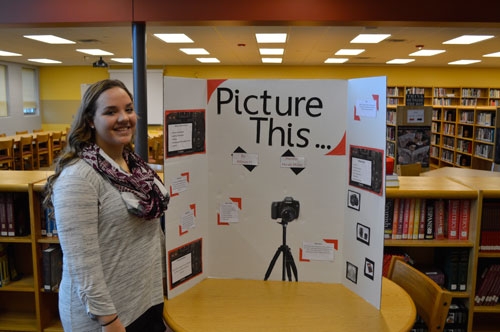You are here
Home ›Waukon High School students answering the question "What do you want to learn?" through 20Time Project

Broader learning perspective through 20Time Project ... Waukon High School junior students in the Honors English 11 class taught by Kris Walleser have been learning more about issues and items that interest them personally by pursuing 20Time projects, an educational process used to incite a broader learning perspective and co-taught with Walleser by Waukon High School Accelerated Learning Program (AALP) instructor Peyton Lapel. Using 20% of their classroom time - each Friday of the five-day school week - the students have been researching a topic of personal interest, having to make early pitch presentations about their project to their fellow students, as pictured above. The students will ultimately present their projects to others in a TEDTalk format later this semester. Standard photo by Jason Meyer.

Picture This ... Waukon High School junior Allison Hagensick selected photography as her 20Time Project. Standard photo by Jason Meyer.

Turning Tables ... Waukon High School junior Emma Hatlan selected furniture refinishing as her 20Time Project. Standard photo by Jason Meyer.
by Jason Meyer
When one thinks of all the questions he or she answers in a day, some are asked by oneself, some are asked of oneself, but all shape who that person is or will become. These questions start in childhood, and continue throughout life. Undoubtedly, one of the most asked is “What do you want to do when you grow up?”. One's career choices guide one's educational path, driving what is learned and how instruction is received.
This instruction, most times, is just that - instruction, lecture, etc., a means of receiving information without the benefit of imparting knowledge or allowing for engagement between the teacher and pupil. Perhaps the more important question to ask is “What do you want to learn?”
Enter, the concept of the 20Time Project.
Based on policies from companies such as 3M, Hewlett Packard, and more famously, Google, the idea is to allow employees 20 percent of their work week, the equivalent of one day, to focus their efforts on projects of interest to them that may be outside the scope of their primary duties. Through such pioneering endeavors, the world now has the use of Post-It Notes, Masking Tape, Google AdSense, and GMail.
A few years ago this concept was introduced in to education, and it’s becoming more prevalent across the nation and the world, with educators reaching out to their students and asking, “What do you want to learn?”
The Allamakee Community School District (ACSD) is no exception, with Waukon High School instructor Kris Walleser asking the 28 pupils in her Honors English 11 course just that.
“The students were instructed to choose something they were passionate about, had always wanted to do, but never had time to,” said Walleser. “This is a crucial part of the project, because if they do not choose something they want to explore, it will be a long five months.”
After choosing their topic, the project began for the students by developing a pitch for their idea; a short presentation of their project, why they chose it and how they were going to accomplish it. Each student then, over the course of three days, pitched their ideas to their classmates and select fellow students of the ACSD.
After their pitch, the students’ real work began. Now, 20 percent of the students' time in Honors English - each Friday - will be devoted to research, and building their idea to fruition. “The students will continue their research and work on their projects every week, in class and out of class on their own time,” noted Walleser. “This is not a project that can be completed in two weeks’ time.”
At the end of the project each student will give a TED-style talk to their classmates, fellow students, and select members of the community, describing their pursuit, the process, and what they learned.
Learning of the project through workshops and independent research, Walleser first implemented the idea in the previous school year on her own. This year, however, Peyton Lapel, with the Allamakee Accelerated Learning Program (AALP), is co-teaching with Walleser.
“I adjusted the timeline from one year to about five months,” said Walleser of this year’s project. “Last year our TED talks began in May, and it was very stressful for all involved due to end-of-year considerations.” To make up for the shortened timeline, Walleser added a few more blog entries for the students to do, and added a research paper element.
Walleser noted that many of the ideas used were gleaned from other educators who have experimented with the 20Time Project and posted their process and results online. “I tweaked those resources,” she said. “Information came from Kevin Brookhouser, who has a web site devoted to the project (20time.org).”
“Administrative feedback has been very positive,” said Walleser. “This project addresses one of our district goals of creating problem solvers, life-long learners, and increasing rigor and relevance in activities that students do. The students really have to think outside the box to accomplish this project.”

